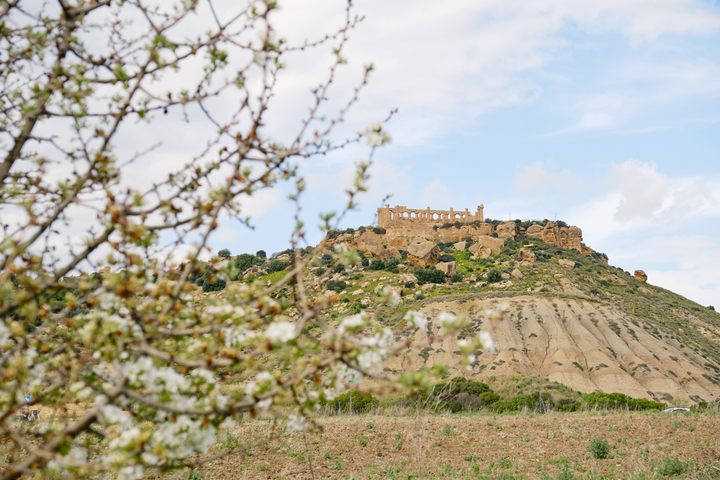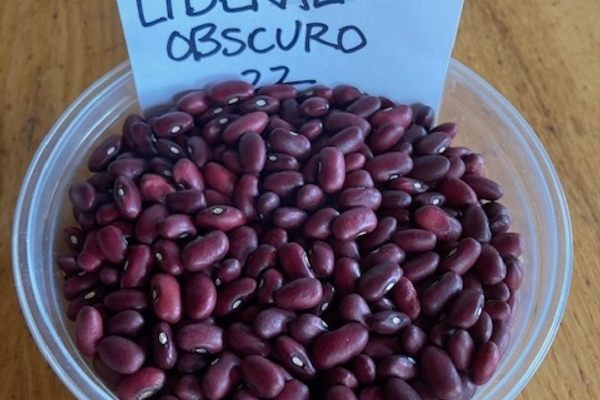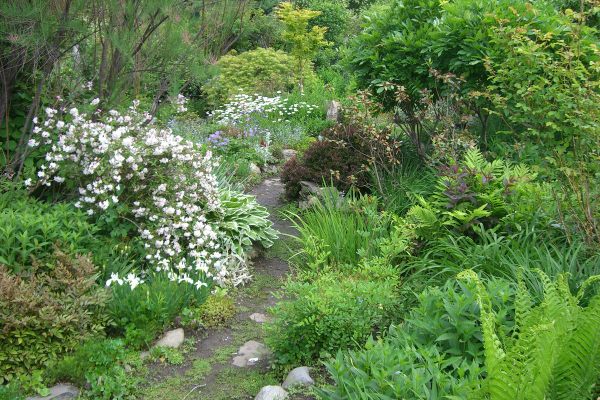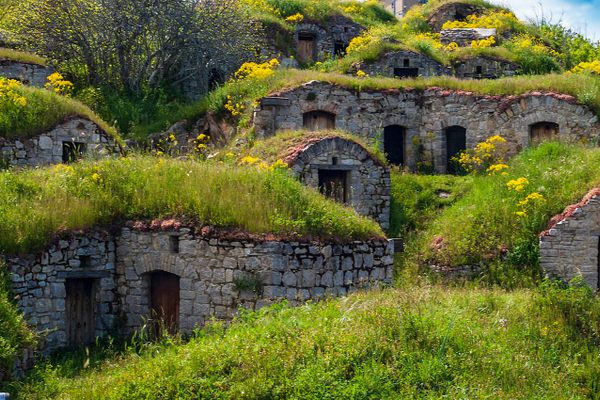

The Ancient Greek Temples Home to Orchards, Vineyards, and Rare Bees
A UNESCO site that doubles as a working farm represents a shift in conservation.
Archaeological ruins are rocks artfully placed and artfully collapsed. Since the Romantics, they have been sites of imagination where we conjure the past. At the Valley of the Temples, which has occupied a ridge outside the city of Agrigento, Italy, for 2,500 years, visitors come to admire the Doric columns and see the stunning Greek structures that have stood through weather and war.
What they see is the skeleton of a long-gone society. Tour guides and didactic panels describe what life was once like, and recreated wood machines sprinkled throughout the site help one imagine how the temples were built. But the structures themselves are lifeless.
If you follow a path from the Temple of Concordia towards the Hellenistic-Roman urban quarter, though, you will find an orchard of almond and pistachio trees bursting white with flowers. This “Living Museum of the Almond Tree,” which stands out among the arid landscape of scrub, contains more than 300 rare Sicilian varieties. If you visit during the summer, you may see local producer Rino Frenda harvesting the nuts to make creams and nougats that he sells under the park’s own label.
The almond orchard is not the park’s only agricultural project: It is home to bees and goats and citrus trees. Often overshadowed by the looming temples, they represent a choice to make the landscape just as important as the temples, to connect the local community to the site through traditions that reach back to ancient Greece, and to conceive of and manage an archaeological site in a different way.

For a long time, conservation management prioritized ruins rather than their surrounding context. The Venice Charter, an influential 1964 document that established a framework for conservation, omitted historic landscapes and gardens, focusing on maintaining ruins as unchanged artifacts. For decades, this narrow vision of culture dominated the field.
But “culture” stems from the Latin word cultura, which means to grow or cultivate. So the professionals in these two silos—archaeology and landscape—got to talking. And according to Mauro Agnoletti, a professor at the University of Florence who teaches landscape history and rural-landscape planning, conservation slowly began to take into account not just the ruins but the surrounding environment. Still, he points out, the Valley of the Temples is a rare case. “We have places where we restore traditional rural landscapes, but not many where you also have archaeological sites.” Only recently have some archaeologists spoken to him about incorporating and restoring the landscape around such monuments.
The administration at the Valley of the Temples has successfully pioneered their unique version of this evolution, though it is a relatively recent and unfolding development. When the ruins were declared a Zone of National Interest in 1966, the focus was on the stones. Even the UNESCO World Heritage Status that was granted in 1997 centered on the Greek ruins, though it hazily gestures beyond. “The vast area proposed for inscription,” the evaluation reads, “may be considered to have something of the nature of a cultural landscape. The row of great temples are the only significant upstanding monuments; the remainder of the site has preserved the rural setting of fields and orchards.” The park’s slow move in this direction became official policy in 2000, when local authorities enshrined in regional law the twinned values of archaeology and landscape, with the added purpose of improving and promoting the landscape that stretches more than 3,200 acres, one of the largest archaeological sites in the world.

This holistic approach, says Roberto Sciarratta, the park’s director, stems from the belief that an archaeological site would be lifeless without considering the aesthetic, environmental, and anthropological factors of the landscape. “It is not possible to imagine the important historical finds that parks preserve without the environmental outline of the landscape.”
Much of the surrounding land had been abandoned by farmers who left the landscape damaged. In rehabilitating the area, the park has invested in the agricultural landscape to both reflect the legacy of the Greeks, in products such as olive oil, honey, wine, and almonds, but also the evolution of the landscape over the centuries, such as the citrus trees brought by the Arabs in the 10th century.
In the late 1990s, along with planting the almond orchard, landscape preservationists started to recreate the fruit orchards of the garden of Kolymbethra. An entrance beside the Temple of Castor and Pollux leads down into a small and verdant valley, into what feels like a secret. In March, the air is perfumed with the scent of orange blossoms. It’s located in what was the artificially created basin that supplied water to the ancient Greek city of Akragas and its hundreds of thousands of residents. The parched earth was brought to life by the aqueducts that collected groundwater from the hills, and it became an important agricultural site over the centuries, with the current incarnation of the garden beginning in the Middle Ages when nearby monks cultivated vegetables and fruits, using varieties and techniques brought by the Arabs. With the rise of citrus cultivation in Sicily at the beginning of the 1700s, the garden evolved into a citrus orchard, and the land was worked until the 1980s, when the last farmers abandoned it, either retiring with no successors, or migrating to wealthier urban areas. Giuseppe Lo Pilato,** the director of the garden and an employee of the National Trust of Italy, which administers the garden separately from the park, began restoring it 20 years ago with the planting of 180 citrus trees.

It’s an important collection, explains Lo Pilato. Half the trees are more than 100 years old, while some were planted in the 1700s. “We have here ancient varieties of citrus that were cultivated in Sicily five or six centuries ago. While the landscape all around was changing, these varieties were kept living here.”
Unlike the monoculture of Washington navel oranges that surround the area and ripen all at once, the various varieties mature throughout the year, from December to May. Paths wind through the valley garden and water runs from pools through restored irrigation canals and across tiled aqueducts first built by the Arabs when the Moors ruled the area.
In March, a major harvest was underway, and the trees’ branches drooped under the weight of copious fruit. Lo Pilato plucked mandarins, clementines, and sweet lemons to sample while speaking passionately about traditional cultivation techniques and organic practices, including the use of predatory insects to protect the trees. We paused at an ancient orange tree, considered to be descended from a wild variety, and which the peasants call a “trickster” orange because of its bumpy skin. “It grows only here,” he says.

Workers packed some of the harvest into crates to be shipped to 200 households across Italy, and saved the rest to turn into marmalades. This was not the original plan. “When we started the restoration works, it was focused on the landscape, the traditional culture, the peasant life,” says Lo Pilato. “But now, since the garden has become so productive, we’ve had to change. Now it’s an agricultural area, not just a beautiful landscape.” A group of local men helped with the harvest through a government work-support program, and until the pandemic hit, the garden offered harvest experiences through Airbnb. When they first began producing marmalade, they made 1,500 jars. This year they’ll produce 42,000, which are sold at the National Trust’s shops around the country and fund the garden.
In 2005, Sciarratta spearheaded the creation of the Diodoros brand to market the park’s agricultural products. The first projects involved olive oil and wine. The company Val Paradiso, a nearby organic olive-oil producer, was chosen to produce oil from the site. They harvest the ancient “Saracen” trees, some 700 years old, that stand next to the Temples of Juno and Concordia. The fruit is then pressed immediately after harvest to obtain an extra virgin olive oil that is delicate and fragrant, and has won national awards.
Wine has been a part of Sicily since the Greeks brought grapes here. Beneath the Temple of Juno, alongside a busy highway, stretches out the vineyard managed by CVA Canicatti, a local cooperative of 300 grape growers. The vineyard’s deep and sandy alluvial soils perfectly suit the island’s native varieties, explains Angelo Molito, a winemaker at CVA. Currently they produce 4,000 bottles, but the park and the cooperative have expanded the grape plantings, which will allow them to produce 13,000 bottles within three years.

These products are now one of the archaeological park’s main priorities, says Sciarratta, and are the tool with which they engage the community and responsibly improve the landscape by instituting organic agricultural practices and using innovative techniques to manage the soil and invasive plants.
These various forms of traditional agriculture, which are low-intensive and sustainable, both express and support the landscape. In 2012, the park welcomed back the rare Sicilian black bee, a threatened species that was thought extinct. Researchers had found a hive in an abandoned house and bred the bees on the Aeolian Islands to avoid cross breeding. The researchers then reintroduced the bee to Sicily by recruiting beekeepers who would breed the species under specific conditions.
This is when Al Kharub was created, says Carmelo Roccaro, president of the social cooperative. They proposed a beekeeping project to aid the reintroduction of this native bee and give work opportunities to people with disabilities and refugees. Their first trainee beekeeper now harvests honey once or twice a year. “It’s important to give a future to the person. We want to give this chance to other people. But we need more bees, we need to sell more honey.” For people to work and care for the land within the park, these projects need to be economically sustainable, says Roccaro. Finding markets to sell the honey has been challenging.

Beyond creating a safe home for these bees, which protects them from pesticides and interbreeding, the bees also pollinize the almond trees. They hope one day to have enough bees to produce a honey just from almond blossoms.
These are the signature projects of the park, but farmers can also apply to plant crops such as capers and grains, which puts to good public use the site’s vast land holdings. Park staff are also studying the possibility of hosting the rare Girgentana goat for milk production. A test study of a few goats can be seen in a pen near the Temple of Concordia. It’s a rare breed of Asian origins, with distinct corkscrew horns, that the Arabs likely introduced around 800. Slow Food has tried to revitalize the species in collaboration with cheese producers because they are productive and their milk is highly digestible, hypoallergenic, and has a less pronounced “goat” flavor than other breeds. Soon there could be cheese for sale.
Sciarratta hopes their example can inspire the curators of other archaeological sites. Still, this model is rare, and Professor Agnoletti struggles to name a similar project. He mentions the archaeological sites of Mides and Chebika in Tunisia, where the local government is thinking of incorporating the ruins of an old Berber village with the oases’ traditional agricultural practices. At Pompeii, the park has recreated a vineyard using Roman techniques. And the restored gardens at Monticello attest to Thomas Jefferson’s obsession with farming and heirloom varieties. Perhaps Cambodia’s rich heritage of rice farming could see paddies surround Angkor Wat. Maybe the steep terraces of Machu Picchu could once again be filled with multi-colored potatoes, maize, and other Andean cultivars like they were 500 years ago. By incorporating traditional agriculture into these sites, we can experience a kind of living past and, perhaps, see the wisdom of these techniques contrasted against our current industrial agriculture.

*Correction: This article previously stated that the temple behind Nino Cuffaro is Temple Vulcano. It is the Temple of Castor and Pollux.
** Correction: This article previously identified Giuseppe Barbera as the director of the garden. He is the director of restoration. The garden director is Giuseppe Lo Pilato.
Gastro Obscura covers the world’s most wondrous food and drink.
Sign up for our regular newsletter.



























Follow us on Twitter to get the latest on the world's hidden wonders.
Like us on Facebook to get the latest on the world's hidden wonders.
Follow us on Twitter Like us on Facebook